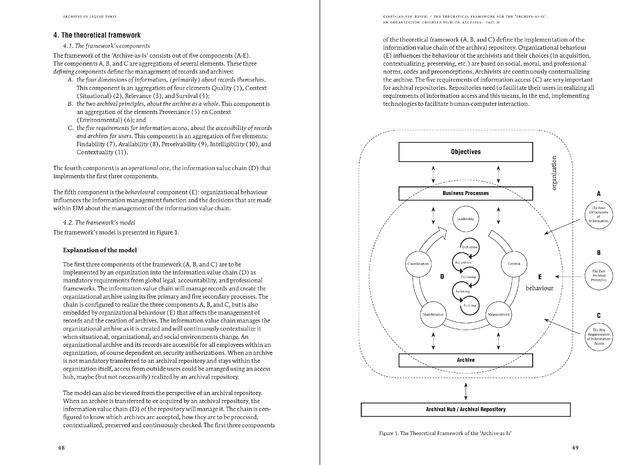geert-jan van bussel the theoretical framework for the 'archive-as-is'
an organization oriented view on archives - part ii
/O
4. The theoretical framework
4.1. The framework's components
The framework of the 'Archive-as-Is' consists out of five components (A-E).
The components A, B, and C are aggregations of several elements. These three
defining components define the management of records and archives:
A. the four dimensions of information, (primarily) about records themselves.
This component is an aggregation of four elements Quality (1), Context
(Situational) (2), Relevance (3), and Survival (4);
B. the two archival principles, about the archive as a whole. This component is
an aggregation of the elements Provenance (5) en Context
(Environmental) (6); and
C. the five requirements for information access, about the accessibility of records
and archives for users. This component is an aggregation of five elements:
Findability (7), Availability (8), Perceivability (9), Intelligibility (10), and
Contextuality (11).
The fourth component is an operational one, the information value chain (D) that
implements the first three components.
The fifth component is the behavioural component (E): organizational behaviour
influences the information management function and the decisions that are made
within EIM about the management of the information value chain.
4.2. The framework's model
The framework's model is presented in Figure 1.
Explanation of the model
The first three components of the framework (A, B, and C) are to be
implemented by an organization into the information value chain (D) as
mandatory requirements from global legal, accountability, and professional
frameworks. The information value chain will manage records and create the
organizational archive using its five primary and five secondary processes. The
chain is configured to realize the three components A, B, and C, but is also
embedded by organizational behaviour (E) that affects the management of
records and the creation of archives. The information value chain manages the
organizational archive as it is created and will continuously contextualize it
when situational, organizational, and social environments change. An
organizational archive and its records are accessible for all employees within an
organization, of course dependent on security authorizations. When an archive
is not mandatory transferred to an archival repository and stays within the
organization itself, access from outside users could be arranged using an access
hub, maybe (but not necessarily) realized by an archival repository.
The model can also be viewed from the perspective of an archival repository.
When an archive is transferred to or acquired by an archival repository, the
information value chain (D) of the repository will manage it. The chain is con
figured to know which archives are accepted, how they are to be processed,
contextualized, preserved and continuously checked. The first three components
of the theoretical framework (A, B, and C) define the implementation of the
information value chain of the archival repository. Organizational behaviour
(E) influences the behaviour of the archivists and their choices (in acquisition,
contextualizing, preserving, etc.) are based on social, moral, and professional
norms, codes and preconceptions. Archivists are continuously contextualizing
the archive. The five requirements of information access (C) are very important
for archival repositories. Repositories need to facilitate their users in realizing all
requirements of information access and this means, in the end, implementing
technologies to facilitate human-computer interaction.
Objectives
behaviour
archives in liquid times
48
Business Processes
Leadership
Definition 1
Acquisition
Coordination
Control
Processing
I Archiving
Auditing I
Maintenance
Measurement
c
rti
tXQ
The Four
Dimensions
nformation
The Two
Archival
Principles
The Five
Requirements
of Information
Archive
Archival Hub Archival Repository
Figure 1. The Theoretical Framework of the 'Archive-as-Is'
49

